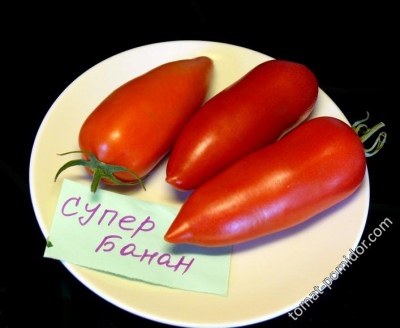
- Category: grade
- Growth type: indeterminate
- Appointment: fresh consumption
- Ripening period: mid-season
- Ripening time, days: 110-115
- Growing conditions: for film greenhouses, for greenhouses
- Bush size: tall
- Bush height, cm: more than 200
- Ripe fruit color: deep red
- Fruit shape: banana
The exotic form is the main advantage of the super banana tomato. True, it looks like an overseas fruit only in shape. The color is red, tomato, the pulp is juicy and fleshy, and many people like the taste. The variety stands out among other crops for its neat banana-shaped fruits, which look very appetizing in a jar and are very easy to fit there.
Description of the variety
A tall, indeterminate two-meter plant, Superbanan, is intended mainly for growing in greenhouses, regardless of whether they are film or glazed. Carp variety, 10-12 tomatoes are formed in each cluster. A big plus is the fact that this is a variety, not a hybrid, and tomatoes that are grown from seeds obtained independently from their own plot have all the qualities of a mother plant.
The main qualities of the fruit
Superbanan tomatoes cause delight and surprise with their banana-shaped elongated fruits up to 20 cm long, their diameter is about 5 cm. Fruit weight - 120-160 g, sometimes more, up to 200 g. The color is intense, bright red. The peel on the fruit is quite dense, the tomatoes are not subject to cracking.
Taste characteristics
Superbanan tomato has a sweet pleasant taste, shaded by a slight sourness. Dense and almost seedless, juicy pulp is another advantage of the variety. Tomatoes will look great as decorative slices, in salads, and just for decorating dishes. They also fit perfectly into salting jars.
Ripening and fruiting
Superbanana is a mid-season crop that fully ripens in 110-115 days.
Yield
The variety in question is considered high-yielding, since up to 9 kg of fruit can be harvested from 1 bush.
The timing of planting seedlings and planting in the ground
Sowing Superbanana seeds for seedlings can be started already at the end of February, but it will not be too late at the beginning of March. It is imperative to perform a pick when the first true sheet appears. If you plan to plant grown seedlings in a greenhouse, then this can be done in the last days of April or in the first half of May.

Growing tomato seedlings is an extremely important process, because it largely depends on whether the gardener will be able to harvest at all. All aspects must be taken into account, from seedbed preparation to planting in the ground.
Landing scheme
In a permanent place, seedlings are placed with a distance of 40 cm, the row spacing will be 60 cm. Thus, there can be no more than 3-4 bushes on one square. To plant the Super Banana, the hole must be 40 cm deep.

Growing and care
The main feature of the Superbanan variety is its poor adaptability to outdoor development. Therefore, it is most often grown in greenhouses.The variety is capricious to temperature extremes, cloudy and rainy weather. Plants need careful formation, constant cleansing from stepchildren, mandatory fastening to a solid and support.
A garter of bushes is done a few days after disembarkation. Formation is carried out in one stem. In addition to the stepchildren, all lower leaves should be removed. The growth point is pinched so that the plant does not grow much. The fruits are removed from the bush as they ripen.
Peat, compost, and wood ash are added as top dressing. Fertilization schedule:
- ten days after the pick;
- 2 weeks after disembarking in the beds;
- during the growing season;
- when fruit ripens.
Watering after top dressing should be abundant. Irrigation is regular, it is carried out 2 to 3 times a week. To avoid fungal infection, waterlogging of the soil should not be allowed. Watering is carried out exclusively at the root - 2.5-3 liters for each plant. After the procedure, it is imperative to loosen the soil to prevent the appearance of crusts. In parallel with loosening, weeds can also be removed. It will be useful to mulch the beds with straw or sawdust.




A plant needs different micronutrients at each stage of growth. All fertilizers can be divided into two groups: mineral and organic. Folk remedies are often used: iodine, yeast, bird droppings, eggshells.
It is important to observe the rate and period of feeding. This also applies to folk remedies and organic fertilizers.



























































































